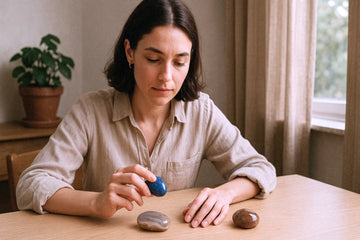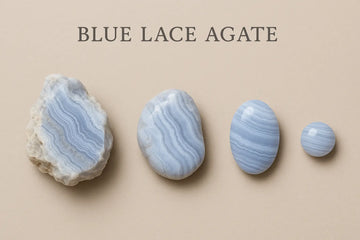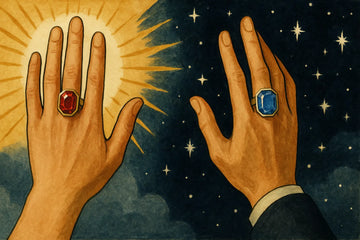The jewelry store in Manhattan’s Diamond District was a vault of quiet opulence. A client, let’s call her Sarah, wasn’t there for an engagement ring. She pointed to a velvet tray holding a glimmering yellow sapphire. “My astrologer said I need to wear this on my right index finger,” she explained, her voice a mix of hope and uncertainty. “For willpower. But… is there a reason it has to be the right hand? I’m left-handed. Does that change anything?”
The salesperson, an older gemologist with a jeweler’s loupe permanently tucked into his eyebrow, smiled a practiced, inscrutable smile. He gave an answer about planetary channels and receiving energies. Sarah bought the ring, but the question lingered, a tiny flaw in the beautiful facade of the belief: Why that hand?
This scene plays out countless times a day, from the ancient gem markets of Jaipur to high-end crystal boutiques in Los Angeles. We are in the midst of a monumental resurgence of belief in the power of stones. But this ancient practice is colliding with a modern, skeptical mind. Are we tapping into the Earth’s hidden energies, or are we participating in a beautifully orchestrated placebo effect, one that’s been polished by tradition and sold to us by algorithms?
To understand, we must journey back—way back.
A Tradition Forged in the Cradle of Civilization
The belief that gems are more than decorative is as old as human fascination with the glittering things we pulled from the dirt. In ancient Vedic texts from India, over 5,000 years old, gems were directly linked to the celestial bodies. Each planet—its energy, its myth, its astrological influence—was represented by a specific stone. Wearing it was a way to harness that planet’s power, to correct cosmic imbalances in one’s life.
This system came with a precise, non-negotiable manual. The body was a map. The left side, passive and receptive, was the channel for energies you wanted to absorb: the calming of the moon (via pearls), the communication of Mercury (via emeralds). The right side, active and projective, was for energies you wanted to emit: the vitality of the sun (via rubies), the discipline of Saturn (via blue sapphires). The logic was internally consistent, elegant, and deeply woven into a holistic view of the universe.
This “left for receiving, right for giving” doctrine is the primary source of the handedness rule. It’s not science; it’s symbolism, a powerful and pervasive language of human culture.
The Scientist’s Lens: A World of Silent Stone
Enter the geologist’s lab. Under the microscope, a gemstone reveals a breathtaking architecture of atoms locked in a precise, repeating crystal lattice. But it is, by all scientific accounts, silent.
Dr. Steven Novella, a neurologist at Yale University and a prominent advocate for scientific skepticism, frames the question with clinical clarity. “The claims of metaphysical gemstone properties fall into the category of pseudoscience. They use the language of science—‘energy,’ ‘vibration’—but without any of the rigor. There is no known biological mechanism by which a gemstone worn on the skin could influence a person’s health, mood, or fortune.”
The most common scientific retort points to the piezoelectric effect. Certain crystals, like quartz, generate a tiny electrical voltage when mechanically stressed. It’s a real, measurable phenomenon. It’s why quartz is inside your watch and your phone. But as Dr. Novella and others point out, this is a red herring.
“The piezoelectric effect requires direct, intentional pressure to create a miniscule charge,” explains Novella. “It is not a passive, ambient energy field emanating from the stone. The idea that this effect is somehow harnessed by wearing a ring or a necklace, and that it then influences something as complex as human destiny, is a profound misunderstanding of the physics involved.”
Professor Terence Hines, a cognitive neuroscientist and author of “Pseudoscience and the Paranormal,” is even more blunt. “If gemstones emitted any form of energy powerful enough to affect human biology, we could easily detect it with our instruments. We can detect gravitational waves from black holes. We can sequence DNA. The fact that we cannot measure any such ‘energy’ from a gemstone is because it doesn’t exist in the way proponents claim.”
The scientific consensus is a brick wall: no energy, no mechanism, no evidence.
So, Why Does It Feel So Real? The Placebo Narratives
If science holds all the cards, why does Sarah genuinely feel a surge of confidence when she wears her yellow sapphire? Why do countless people swear by the calming properties of their amethyst?
The answer may lie not in the stone, but in the story.
The placebo effect is one of the most powerful and well-documented phenomena in medicine. It’s not “just in your head”; it’s a real psychobiological event. Belief can trigger the release of endorphins, dopamine, and other neurotransmitters that actually alter perception and alleviate symptoms.
A gemstone, especially one chosen through a meaningful ritual—consulting an astrologer, receiving it as a gift, investing in it for a specific intention—becomes a potent symbolic trigger. The act of putting it on is a ritual. Every glance at it on your hand is a subconscious reinforcement of that intention: “I am confident,” “I am protected,” “I am calm.”
The narrative itself is the treatment. The stone is the catalyst for the narrative.
This explains the handedness conundrum for left-handed people. The rule is about the body’s symbolism, not manual dexterity. But more importantly, if a left-handed person believes the stone works better on their right hand, it likely will—for them. The power of belief is flexible where rigid tradition is not.
And what of “recharging” a stone in the moonlight? Science sees a stable mineral structure utterly unchanged by photons reflected from the sun. But psychology sees a powerful reset ritual. By cleansing the stone, you are cleansing your own intention. You are wiping the slate clean, metaphorically renewing your commitment to the goal you’ve project onto the stone. It’s a form of mindfulness.
The Enduring Sparkle
So, are we just fooling ourselves? Perhaps. But it might be a beautiful, necessary, and even beneficial self-deception.
We live in a disenchanted world, often stripped of mystery and meaning. Gemstones offer a tangible connection to the ancient, the earthly, and the cosmic. They are anchors for our intentions and narratives for our desires. The human brain is a story-making machine, and we are drawn to symbols that help us tell a better story about our own lives.
The salesperson in the Diamond District and the Yale neurologist exist in different universes of explanation. One deals in the poetry of symbolism, the other in the prose of empirical data.
Sarah’s yellow sapphire, then, holds two truths. The first truth: it is a nearly perfect crystal of aluminum oxide, colored by trace elements of iron and titanium, formed under immense heat and pressure deep within the Earth. It possesses no energy that can grant willpower.
The second truth: it is a Sun Stone, a token of intention, a gleaming reminder on her finger of the person she wants to be. And that truth, while unscientific, can sometimes be powerful enough to change a life all on its own.
The gemstone’s real magic isn’t held in its lattice; it’s reflected in the eyes of the believer. And that is a mystery that neither geology nor astrology can fully contain.



